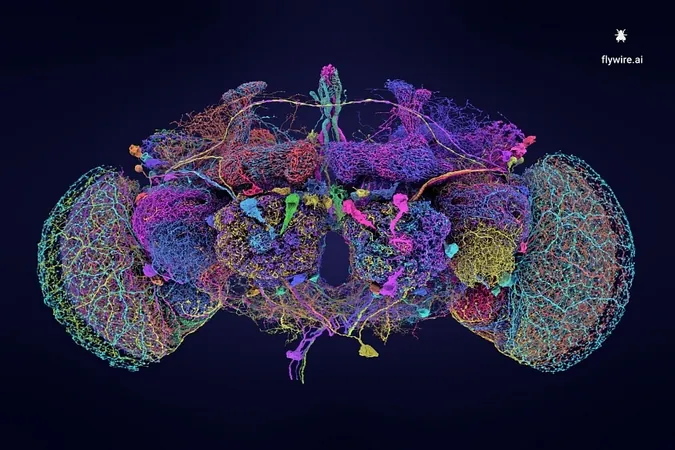
Revolutionary Breakthrough: Scientists Decode Fruit Fly Brain in Groundbreaking Neurobiological Study
2024-10-02
Author: Wei Ling
Groundbreaking Announcement
In a groundbreaking announcement on October 3, researchers revealed a remarkable achievement in neurobiology: the complete mapping of the brain of an adult fruit fly, scientifically known as *Drosophila melanogaster*. This monumental task uncovered over 50 million connections among more than 139,000 neurons in the tiny insect’s brain, offering potential insights into neurological processes across the animal kingdom, including humans.
Implications for Understanding Brain Function
This monumental study not only dissects the intricate wiring of the fruit fly’s brain but also aims to unravel the signaling mechanisms crucial for healthy brain function. The implications are staggering. As one of the leaders of the research, Princeton University’s Sebastian Seung, pointed out, understanding a single brain—no matter how small—can shed light on the complexities of all brains. "If we can truly understand how any brain functions, it’s bound to tell us something about all brains," he stated.
Aesthetic Beauty of Fruit Fly Brains
Many may dismiss fruit flies as mere nuisances, but the aesthetic beauty of these creatures' brains captivated some researchers. Gregory Jefferis, a neuroscientist from the University of Cambridge and co-leader of the project, expressed his admiration: “It’s beautiful,” he said, referring to the tiny, intricate architecture of the fly’s brain, which is less than 1 millimeter wide.
Development of a Wiring Diagram
The researchers developed a wiring diagram—a connectome—for the adult fruit fly's brain. This level of detail surpasses earlier studies of simpler organisms, such as the roundworm *Caenorhabditis elegans* and the larval stage of the fruit fly. The adult fruit fly, with its more sophisticated behaviors, presents a more complex target for neuroscientific exploration.
Research Team and Their Investigations
The team of researchers, part of the FlyWire Consortium, undertook a series of studies aimed at understanding how the connections and neurons in the fruit fly brain correspond to behaviors. Mala Murthy, also a co-leader, emphasized the importance of these insect models: "They solve many of the same problems we do and exhibit advanced behaviors including walking, flying, learning, memory, navigation, feeding, and even social interactions."
Innovative Investigations
Among the innovative investigations, one study focused on the brain circuits that control walking, revealing the mechanisms by which flies stop. Another explored the gustatory system, analyzing the neural pathways involved when flies use their legs to groom themselves. The research also delved into the visual processing of motion and color and uncovered a multitude of "hub neurons," which facilitate rapid communication within the brain.
Mapping Coordination and Behavioral Circuits
Notably, the study mapped the coordination of the hemispheres and behavioral circuits within the fly's brain, detailing various neuron types and synapses—the chemical connections between nerve cells. Understanding the neurotransmitters involved in these processes could guide future research in both insect and human neurobiology.
Impact on Future Brain Mapping Endeavors
This remarkable project marks a pivotal moment in our understanding of animal brains and may lay the groundwork for more complex brain mapping endeavors in the future. As researchers continue to decode the intricacies of the nervous system, the findings from this fruit fly study promise to illuminate not only the brains of insects but also the fundamental principles governing all brain activity—including our own.



 Brasil (PT)
Brasil (PT)
 Canada (EN)
Canada (EN)
 Chile (ES)
Chile (ES)
 España (ES)
España (ES)
 France (FR)
France (FR)
 Hong Kong (EN)
Hong Kong (EN)
 Italia (IT)
Italia (IT)
 日本 (JA)
日本 (JA)
 Magyarország (HU)
Magyarország (HU)
 Norge (NO)
Norge (NO)
 Polska (PL)
Polska (PL)
 Schweiz (DE)
Schweiz (DE)
 Singapore (EN)
Singapore (EN)
 Sverige (SV)
Sverige (SV)
 Suomi (FI)
Suomi (FI)
 Türkiye (TR)
Türkiye (TR)